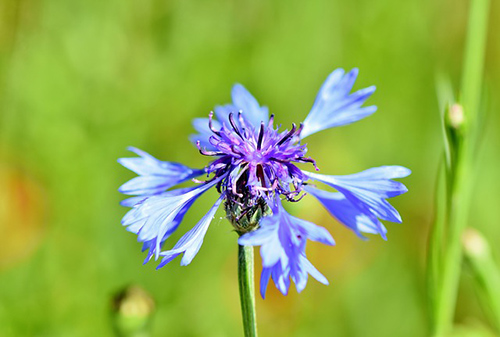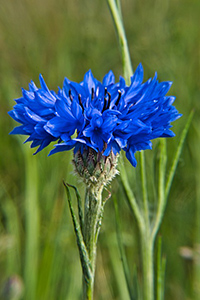Contents
The cornflower plant covers the golden prairies from late spring onwards with its elegant blue flowers. For hundreds of years, the seeds of crops have been mixed with cornflower seeds and dispersed worldwide. Pliny the Elder, a 1st-century Roman botanist, portrayed the cornflower plant as “an annoying flower for harvesters,” who did everything they could not to cut it with their sickles and scythes. Also, other classical writers have given us other positive words about this delicate plant.
Mattioli, a 16th-century botanist who declared that “the blue flowers of this plant alleviate reddened eyes, ” discovered the medicinal virtues of the cornflower plant.” According to Mattioli, the healing virtues result from the blend of opposite colors, red vs. blue, following the theory of signs.

Cornflower Plant Scientific Facts
- Other names: Bluebottle, cyani, bachelor’s button, bluebonnet, blue centaury.
- French: Bleuet.
- Spanish: Azulejo, aciano, ojeras.
- Environment: It mainly grows in crop fields throughout Europe, though it has also reached America. The cornflower plant is less common in the southeastern provinces of the European Union.
- Description: The cornflower plant is a member of the Compositae family. Its thin, rigid stem can grow up to 50 centimeters high. It contains complex, brightly blue-colored flowers and narrow leaves, which appear to be covered with a smooth velvet layer.
- Parts of the plant used medicinally: Flowers.
Healing Properties and Indications
The flowers contain anthocyanins and polyamines, whose actions are antiseptic and anti-inflammatory, bitter substances that act as appetizers and eupeptic (that facilitate digestion), and flavonoids with a mild diuretic effect. The flowers should be taken in infusions before meals. It is better not to sweeten the infusions.

Cornflower water, obtained by decoctioning its flowers, is primarily used in eyelid applications due to its notable anti-inflammatory effect. Eye irrigation and baths with cornflower water ease itching and irritation and give tired eyelids a fresh and smooth look. Thus, in many places, this plant is named “bags under the eyes.”
People who wash their eyes with cornflower water obtain a limpid and shimmering gaze that flashes like the tiny blue flowers of the cornflower in golden wheat fields.
- Conjunctivitis (swelling of the mucous membrane that covers the anterior membrane that covers the anterior part of the eyes). Eye cleansing with cornflower water and eye drops will help eliminate eye secretions (sleep) and make eye congestion disappear.
- Blepharitis (inflammation of the eyelids) and styes (little furuncles that appear on the edge of the eyelids) are common conditions. In these cases, cornflower water in compresses or eye baths is recommended.
The cornflower plant was supposed to clear and preserve vision in ancient times, although only blue-eyed people. Thus, in French, this plant is called casselunetters (glasses-breaker). Today, we know this was merely a myth; nevertheless, we should remember that cornflower is good for the eyes.
How to use Cornflower

- Infusion: Use twenty to thirty grams of young flowers per liter of water. Have one cup before each meal.
- Cornflower water. To get it, if possible, use fresh flowers decocted in a fraction of thirty grams (two tablespoons) for every liter of water. Make sure to let it boil for five minutes. Then, apply it to the eyes while it is warm; you can accomplish this in one of the following ways:
Compresses. Soak gauze and hold it over the afflicted eye for fifteen minutes, twice or thrice daily.
Eye bath: Put cornflower water in a proper container or wring a soaked cloth over the affected eye. The water must fall from the temple to the nose.
– Eye drops. A few drops of cornflower water into the eye three times a day.
DISCLAIMER: All content on this website is presented solely for educational and informational objectives. Do not rely on the information provided as a replacement for advice, diagnosis, or treatment from a qualified medical expert. If you are pregnant, nursing, or have any preexisting medical concerns, talk to your doctor before using any herbal or natural medicines.
REFERENCES
- George D. Pamplona-Roger, M.D. “Encyclopedia of Medicinal Plants.” George D. Pamplona-Roger, M.D. Encyclopedia of Medicinal Plants. Ed. Francesc X. Gelabert. Vols. 1 San Fernando de Henares: Editorial Safeliz, 2000. 131, 132. Print.
- WebMD: https://www.webmd.com/vitamins/ai/ingredientmono-414/cornflower
- Health: https://www.bloomybliss.com/2023/05/how-cornflower-tea-can-improve-your-skin-hair-and-health/
Last update on 2025-06-04 / Affiliate links / Images from Amazon Product Advertising API





